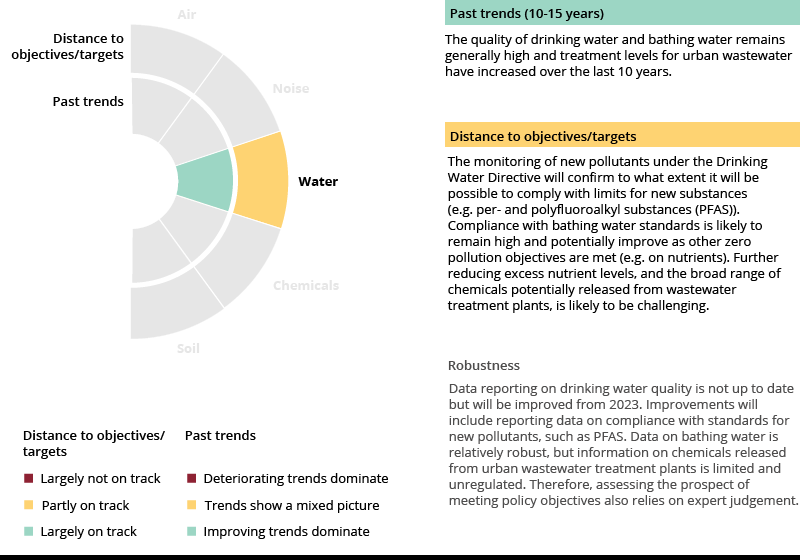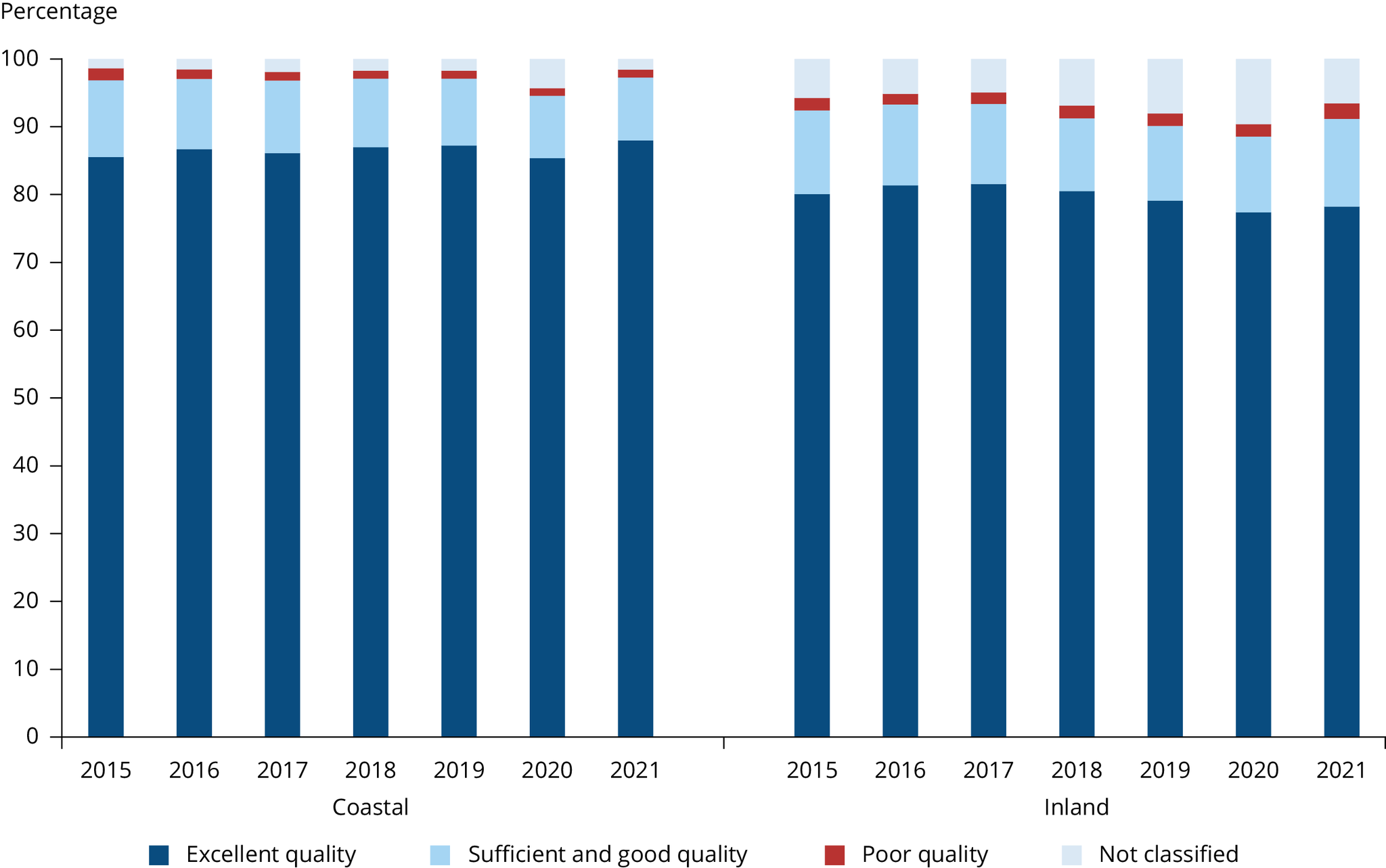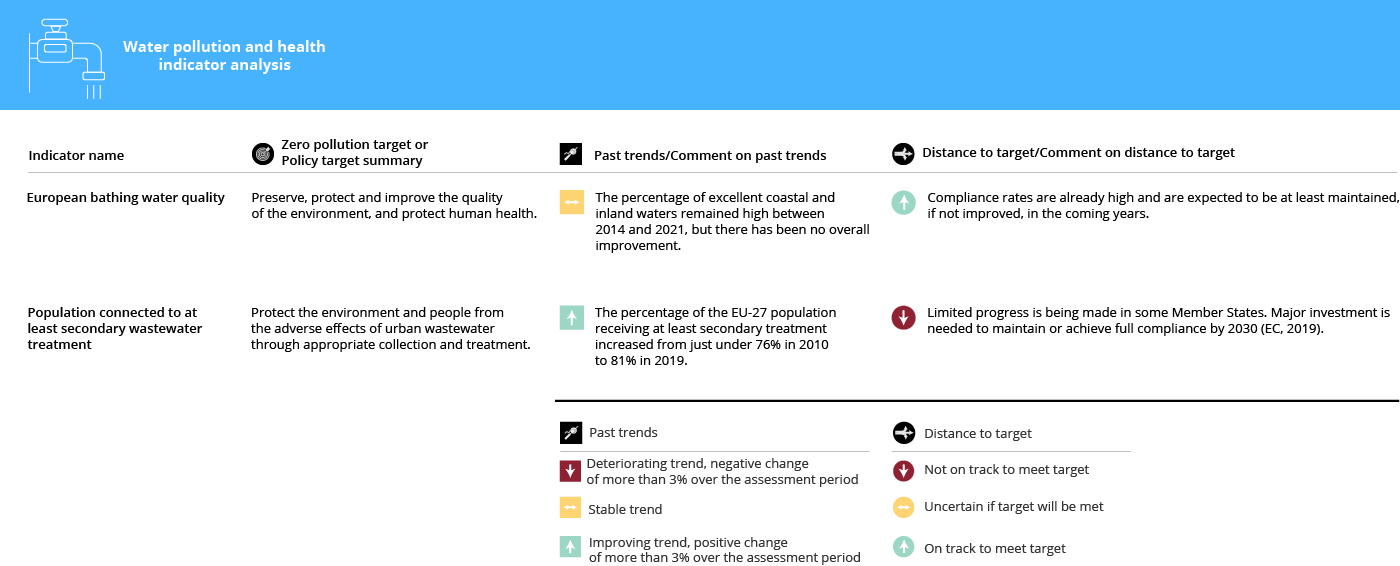Key messages
- Bathing water quality is consistently classified as good across much of the EU.
- Compliance with drinking water standards is also excellent. However, the range of chemical pollutants monitored to date is limited. More extensive monitoring is likely to provide evidence of a broader range of potentially harmful pollutants in drinking water.
- Improved urban wastewater treatment has successfully reduced pollutant concentrations in water. However, treatment plants cannot always effectively remove all pollutants — posing risks to health associated with antimicrobial resistance and chemical contaminants.

Guidance for interpreting the summary
The infographic above summarises the overall findings on water pollution. Two dimensions are assessed:
- whether the recent trend in pollution is positive, negative or uncertain
- the current 'distance to target', based on an assessment of the current trends or status and whether or not the EU is on track to achieve the defined zero pollution targets for 2030 and/or other relevant policy targets.
The assessment is based on a combination of (1) available indicators and data, and (2) expert judgement.
Introduction
Access to clean water is essential for health, drinking and food preparation. It also plays a vital role in hygiene and sanitation systems. Polluting waterbodies with chemicals, nutrients or bacteria presents risks to health and well-being — both directly, through drinking or bathing water contamination, and indirectly, through food product contamination. Food contamination is considered in the health and chemicals section of the zero pollution assessment.
This section specifically examines the issues of bathing water, drinking water and urban waste water treatment from a health perspective. For more detailed information, see the zero pollution monitoring assessment on ecosystems, which includes a further assessment of pollution risks posed to our freshwater, soil and marine environments.
Managing water quality in Europe
In the EU, the quality of bathing water and the quality of water for human consumption are regulated under the Bathing Water Directive and the Drinking Water Directive, respectively. Urban wastewater treatment is fundamental to ensuring public health and environmental protection and is regulated under the Urban Wastewater Treatment Directive. A proposal for a revised Urban Wastewater Treatment Directive (with an accompanying impact assessment) was published in October 2022 as part of a zero pollution legislative package, further strengthening protective measures for both human health and the environment.
Recent legislation on water reuse aims to stimulate and facilitate safe water reuse in the EU, and gives rise to the following question: can pollutants in treated wastewater and sludges be absorbed by plants and enter the human food chain?
Bathing water
In 2021, 95% of bathing waters in Europe met the minimum quality requirements under the Bathing Water Directive; the majority are of excellent quality, according to EEA (2022) (Figure 14). Overall, coastal bathing sites tend to be cleaner than inland sites. Compliance also varies across countries.

Note: The assessment is based on measuring the concentration of two bacteria, namely intestinal enterococci and Escherichia coli (indicators of pollution with human faecal matter).
Source: EEA (2022).
Click here for different chart formats and data
Increased nutrient (e.g. nitrogen) concentrations can alter aquatic ecosystems to such an extent that they become unsuitable for bathing and as a source of drinking water, driving cyanobacterial blooms (see zero pollution ‘Signal’ on cyanobacteria) and presenting a risk to health. Nutrients in water are further addressed in the section on freshwater pollution, in the section on pollution from production and in the cross-cutting story on nutrients.
Drinking water
The first Drinking Water Directive sets quality standards for 48 microbiological, chemical and indicator parameters. Systematic monitoring (over 7 million analyses) found a compliance rate of more than 99.5% for a range of chemical parameters based on the most recent data (EC, 2016).
However, the number of parameters monitored was limited and did not include more recently identified pollutants of concern, leading to the adoption of the revised Drinking Water Directive in 2021. This directive includes additional parameters, including chemicals of current concern such as per- and polyfluorinated compounds (PFAS) (see the zero pollution cross-cutting story on PFAS) and bisphenol A, and sets limit values for their presence in drinking water. It also introduces a ‘watch list’, which enables each country to look for evidence of additional pollutants.
EU-level data on drinking water quality are limited (the most recent data are from 2011 to 2013), highlighting the need for a more agile and timely approach to collecting and reporting data on drinking water quality.
The new directive also focuses on improving access to safe drinking water for all. The impact assessment that supported the revision of the directive (EC, 2018) estimated that, without additional measures, more than 100 million citizens would potentially face long-term health risks in 2030 from polluted drinking water. This varied across Member States from 13%-14% of the population being at risk (in Cyprus and Slovenia) to up to 29%-31% being at risk (in Belgium, Finland, Latvia, Malta and Romania).
According to data from the World Health Organization (WHO)/United Nations Children’s Fund (Unicef) Water and Sanitation Hygiene (WASH) database, the level of access to clean drinking water in Europe is high. However, the levels of treatment and accessibility are lower in rural areas than in urban locations. There are also disparities in access to safe drinking water among ethnic groups in Europe. The Roma are the largest ethnic minority in the EU and significant parts of the Roma population live in settlements without access to tap water (FRA, 2016; ERRC, 2017). Migrants and asylum seekers in Europe also suffer from limited access to drinking water, with specific concerns about Europe’s formal and informal refugee camps being raised by the United Nations High Commission for Refugees (see UNHCR, 2020).
Urban wastewater treatment
A recent evaluation (EC, 2019) of the Urban Wastewater Treatment Directive concluded that it has been effective in two key areas: (1) reducing organic matter and other pollution in treated wastewater and (2) improving water quality throughout the EU. The directive’s main objective is to protect surface waters from oxygen-consuming organic pollution, which degrades aquatic life, and microbiological contamination with pathogens. The proportion of the European population connected to urban wastewater treatment plants and the level of treatment being applied has improved significantly over recent decades, reducing releases of untreated effluent into the environment (Eurostat, 2022). Further information on the implementation of the Urban Wastewater Treatment Directive in each EU Member State is available in the WISE country profiles. While many countries have fully implemented the requirements, the process has been significantly delayed in some countries and others lag behind. Maintaining or achieving full compliance by 2030 will require an estimated additional EUR 253 billion investment (EC, 2019), hence achieving full implementation will be challenging.
Chemicals in a range of consumer products, such as medicines, cosmetics and personal care products, also enter wastewater treatment plants. The treatment systems are principally designed to remove solids, organic material, microbes and nutrients, meaning that they are only partially effective at removing chemicals; as a result, many chemicals are partitioned from treated effluent into sewage sludge or are released into receiving waters untreated. A 2017 study examining pharmaceuticals in the Baltic Sea found that, of 118 pharmaceutical compounds, only nine were removed from wastewater with an efficiency of over 95% — and around half were removed with an efficiency of less than 50% (Unesco and Helcom, 2017).
Approximately half of all sewage sludge produced by Member States is spread on agricultural land as fertiliser and a quarter is incinerated. Sludge can contain high concentrations of metals, pathogens and persistent organic pollutants — so its use on land is restricted in some Member States to protect the environment (EEA, 2021). The Sewage Sludge Directive sets limits for only heavy metals in sludges and does not address other pollutants such as microplastics, organic pollutants and pharmaceuticals, which have recently been identified as pollutants of concern (see the zero pollution ‘Signal’ on sludge spreading impacts). Some Member States have also chosen to apply additional limits at a national level (Mininni et al., 2015). Once chemicals are released into the environment, they can cause downstream health-related issues such as promoting antimicrobial resistance (see the zero pollution ‘Signal’ on antimicrobial resistance) and polluting drinking water sources, as outlined in the zero pollution cross-cutting story on PFAS. Very little monitoring data are available on these releases, because this is not a requirement under the directive. However, there is evidence to indicate that these organic and inorganic pollutants may present a significant risk (Aemig et al., 2021).
The potential risks posed by pollution from sludges and wastewaters highlight the importance of applying the zero pollution hierarchy. Upstream prevention is more efficient than attempting to remove a very broad range of pollutants once they are already in wastewaters and entering surface waters.
A proposal for a revised Urban Wastewater Treatment Directive has recently been published (EC, 2022a). The revision aims to address issues such as storm water overflows and pharmaceutical residues in water — which can encourage antimicrobial-resistance genes to develop in the wastewater system. The impact assessment accompanying the revised directive (EC, 2022b) estimates that the improvements will result in a 44% reduction in the toxic load entering receiving waters, further protecting bathing waters and drinking water sources. The revised directive will also improve our knowledge base through better monitoring, including on antimicrobial resistance.
Note: Link to indicators: European bathing water quality, Population connected to at least secondary wastewater treatment
Overview of indicator analysis methodology
This indicator analysis is in line with the approach taken by the EEA for its seventh environment action programme monitoring.
Past trends are based on assessment of the trend over the last 10 years (or since the relevant zero pollution baseline year where appropriate) with green, yellow or red being applied based on the criteria as outlined in the figure legend. Expert judgement is also applied, for example in cases where indicators are more qualitative and/or uncertain.
The distance to target is based on an assessment of the recent trend, current status and expert judgement.
Further detailed analysis of the future outlook for meeting certain zero pollution targets is included in the zero pollution outlook 2022, completed by the European Commission Joint Research Centre (JRC, 2022).
References
Aemig, Q., et al., 2021, ‘Impact assessment of a large panel of organic and inorganic micropollutants released by wastewater treatment plants at the scale of France’, Water Research188, 116524 (https://doi.org/10.1016/j.watres.2020.116524).
EC, 2016, Report from the Commission — Synthesis report on the quality of drinking water in the Union examining Member States’ reports for the 2011-2013 period, foreseen under Article 13(5) of Directive 98/83/EC (COM(2016) 666 final of 20 October 2016) (https://ec.europa.eu/environment/water/water-drink/pdf/reports/EN.pdf) accessed 6 October 2022.
EC, 2018, Commission staff working document — Impact assessment accompanying the document ‘Proposal for a Directive of the European Parliament and of the Council on the quality of water intended for human consumption (recast)’ (SWD(2017) 449 final of 1 February 2018) (https://eur-lex.europa.eu/legal-content/EN/TXT/PDF/?uri=CELEX:52017SC0449&from=EN) accessed 6 October 2022.
EC, 2019, Commission staff working document — Evaluation of the Council Directive 91/271/EEC of 21 May 1991, concerning urban waste-water treatment (SWD(2019) 700 final of 13 December 2019) (https://ec.europa.eu/environment/water/water-urbanwaste/pdf/UWWTD%20Evaluation%20SWD%20448-701%20web.pdf) accessed 6 October 2022.
EC, 2022a, Proposal for a Directive of the European Parliament and of the Council concerning urban wastewater treatment (recast), (SWD(2022) 541, 544), (https://environment.ec.europa.eu/document/download/a936c2d5-2e3a-4eb1-a7c6-41ec98f3e72f_en?filename=Proposal%20for%20a%20Directive%20concerning%20urban%20wastewater%20treatment%20%28recast%29.pdf) accessed 26 October 2022.
EC, 2022b, Commission staff working document – impact assessment accompanying the document ‘Proposal for a directive of the European Parliament and of the Council concerning urban wastewater treatment (recast), (COM(2022) 541 Final) (https://environment.ec.europa.eu/document/download/0c65f57a-9db0-4665-b5e4-e2ba671de95d_en?filename=Impact%20assessment%20accompanying%20the%20proposal.pdf), accessed 26 October 2022.
EEA, 2021, ‘Urban waste water treatment for 21st century challenges’, European Environment Agency (https://www.eea.europa.eu/publications/urban-waste-water-treatment-for/urban-waste-water-treatment) accessed 7 October 2022.
EEA, 2022, ‘European bathing water quality in 2021’, European Environment Agency (https://www.eea.europa.eu/publications/bathing-water-quality-in-2021/european-bathing-water-quality-in-2021) accessed 7 October 2022.
ERRC, 2017, Thirsting for justice: Europe’s Roma denied access to clean water and sanitation, European Roma Rights Centre, Budapest (http://www.errc.org/uploads/upload_en/file/thirsting-for-justice-march-2017.pdf) accessed 6 October 2022.
Eurostat, 2022, ‘SDG 6 Clean Water and Sanitation’, Eurostat (https://ec.europa.eu/eurostat/web/sdi/clean-water-and-sanitation), accessed 21 November 2022.
FRA, 2016, Second European Union minorities and discrimination survey: Roma — selected findings, EU-MIDIS II, European Union Agency for Fundamental Rights, Luxembourg, (https://fra.europa.eu/en/publication/2016/second-european-union-minorities-and-discrimination-survey-roma-selected-findings) accessed 6 October 2022.
JRC, 2022, Zero pollution outlook 2022, JRC129655, Publications Office of the European Union, Luxembourg, Joint Research Centre (https://joint-research-centre.ec.europa.eu/zero-pollution-outlook-2022_en) accessed 1 December 2022.
Mininni, G., et al., 2015, ‘EU policy on sewage sludge utilization and perspectives on new approaches of sludge management’, Environmental Science and Pollution Research22, pp. 7361-7374 (https://doi.org/10.1007/s11356-014-3132-0).
Unesco and Helcom, 2017, Pharmaceuticals in the aquatic environment of the Baltic Sea region — a status report, Emerging Pollutants in Water Series No 1, United Nations Educational, Scientific and Cultural Organization, Paris (https://www.helcom.fi/wp-content/uploads/2019/08/BSEP149.pdf) accessed 6 October 2022.
UNHCR, 2020, ‘Act now to alleviate suffering at reception centres on Greek islands — UNHCR’s Grandi’, United Nations High Commissioner for Refugees (https://www.unhcr.org/news/press/2020/2/5e4fe4074/act-alleviate-suffering-reception-centres-greek-islands-unhcrs-grandi.html) accessed 7 October 2022.
Cover image source: © Evangelija Ivanoska, Well with Nature /EEA



Document Actions
Share with others